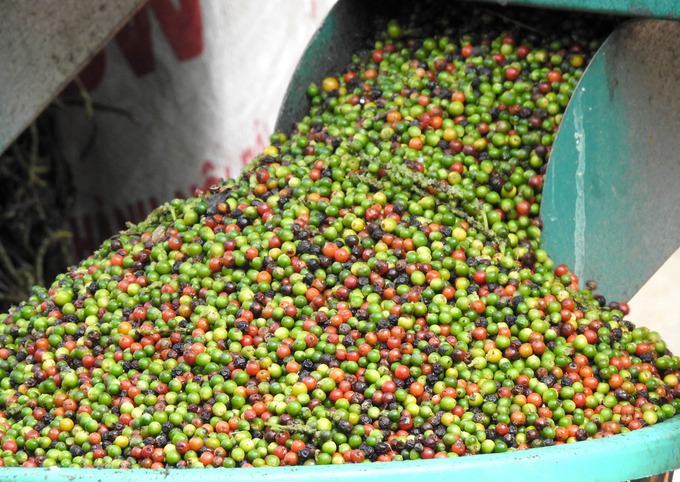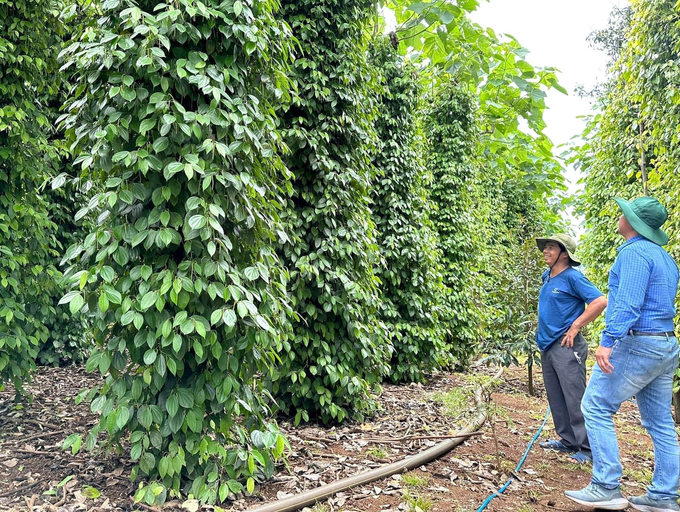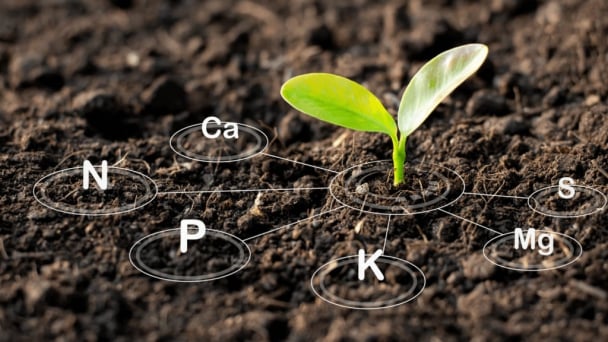May 20, 2025 | 18:42 GMT +7
May 20, 2025 | 18:42 GMT +7
Hotline: 0913.378.918
May 20, 2025 | 18:42 GMT +7
Hotline: 0913.378.918

Vietnam's pepper yield in 2024 is projected to be the lowest in the last five years. Photo: Son Trang.
According to the General Department of Vietnam Customs, Vietnam's pepper exports reached 13 thousand tons with an estimated turnover of 54 million USD in February 2024, marking a decrease of 23% in volume and a decrease of 220% in value compared to January 2024; a decrease of 52% in volume and a decrease of 35% in value compared to February 2023.
Vietnam's pepper exports reached 31 thousand tons with an estimated turnover of 124 million USD within the first two months of 2024, marking a decrease of 24% in volume and a decrease of 2.1% in value compared to the same period in 2023.
The sharp decline in pepper exports can be primarily attributed to the overall reduced yield. The Vietnam Pepper and Spice Association (VPSA) previously forecast a decrease of 10% in annual pepper yield for the 2023/2024 crop, with a total estimated volume of 170 thousand tons. However, according to assessments from several traders based on the current state of harvest across multiple pepper-producing provinces, this year's yield is estimated to reach approximately 140 to 150 thousand tons. On the other hand, Mr. Nguyen Tan Hien, Vice Chairman of VPSA, believes that Vietnam's pepper yield in 2024 will be the lowest in the last five years.
The sharp decrease in pepper imports in 2023 also affected Vietnam's pepper exports in early 2024. Vietnamese pepper businesses have primarily imported additional pepper from Indonesia, Cambodia, and especially Brazil to meet the demand for export orders. However, due to the reduced pepper yield across multiple countries and high prices in 2023, pepper imports to Vietnam decreased by 28% compared to 2022, reaching 27 thousand tons.

A pepper farm in Bu Dop district, Binh Phuoc province. Photo: Son Trang.
Vietnam's pepper yield in 2023 increased by 3.8% compared to 2022; however, pepper exports rose by 14%. Additionally, pepper imports remained relatively high, as previously reported. These factors led to a low inventory of pepper in Vietnam during the transitioning between 2023 and early 2024, which contributed significantly to the sharp decline in pepper exports in the first two months of 2024.
Farmers' reluctance to sell the recent pepper harvest has also had a considerable impact on Vietnam's pepper exports. Mr. Nguyen Vu, a farmer in Tan Binh hamlet, Tan Tien commune, Bu Dop district, Binh Phuoc province, shared that pepper prices in his area has steadily risen following the Lunar New Year holiday, with the highest level being 97,000 Vietnamese dong per kilogram. Similarly, the prices of organic pepper can reach up to 100,000 Vietnamese dong per kilogram. Despite these high prices, the majority of pepper-producing households stockpile their harvest, in anticipation that this year's pepper prices may reach over 100,000 Vietnamese dong per kilogram.
The decline in pepper export growth is expected to persist throughout March 2024. According to the General Department of Vietnam Customs, Vietnam exported 12 thousand tons of pepper in the first half of March 2024, which is 5,000 tons lower compared to the first half of March 2023.
Vietnamese businesses typically export the most amount of pepper during March. Namely, 36 thousand tons of pepper were exported in March 2023, with exports in the remaining months falling under 30 thousand tons. However, with the current scarcity of supply, it will be challenging for Vietnam's pepper exports to reach the 30 thousand-ton mark in March 2024.
Although domestic pepper yield is reduced and farmers are reluctant to sell their harvest, businesses are required to purchase pepper to fulfill their export orders. As a result, pepper prices in March 2024 have remained at above 90,000 Vietnamese dong per kilogram. At the beginning of this week, pepper prices in the Central Highlands and Southeast regions ranged from 92,500 to 96,000 Vietnamese dong per kilogram, which are the highest price levels since 2017.
The United States is the largest market for Vietnamese pepper in the first two months of 2024, with a volume of 31 thousand tons and a value of 37 million USD, marking an increase of 25% in volume and an increase of 29% in value compared to the same period in 2023. Additionally, the United States accounted for 28% of Vietnam's pepper export market share in early 2024, which is an increase from 23% in the same period of 2023.
Translated by Nguyen Hai Long

(VAN) Japan's grant aid project contributes to capacity building, promoting organic agricultural production, and fostering sustainable community development in Dong Thap province.

(VAN) For years, the CRISPR-Cas9 genome technology has been reshaping genetic engineering, a precision tool to transform everything from agriculture to medicine.

(VAN) Vietnam aims to become a 'leader' in the region in the capacity and managing effectively soil health and crop nutrition.
![Reducing emissions from rice fields: [Part 1] Farming clean rice together](https://t.ex-cdn.com/nongnghiepmoitruong.vn/608w/files/news/2025/05/05/z6509661417740_a647202949c539012a959e841c03e1d3-nongnghiep-143611.jpg)
(VAN) Growing clean rice helps reduce environmental pollution while increasing income, allowing farmers to feel secure in production and remain committed to their fields for the long term.
/2025/05/19/5136-1-144800_230.jpg)
(VAN) The Nghe An Provincial People's Committee has just approved the list of beneficiaries eligible for revenue from the Emission Reductions Payment Agreement (ERPA) in the North Central region for the year 2025.

(VAN) 14 out of 35 domesticated elephants in Dak Lak province have had their living conditions improved, with 11 of them currently participating in the non-riding elephant tourism model.

(VAN) Muong Nhe Nature Reserve hopes that being upgraded to a national park will lay the foundation for forest protection efforts to be carried out in a systematic, modern, and sustainable manner.